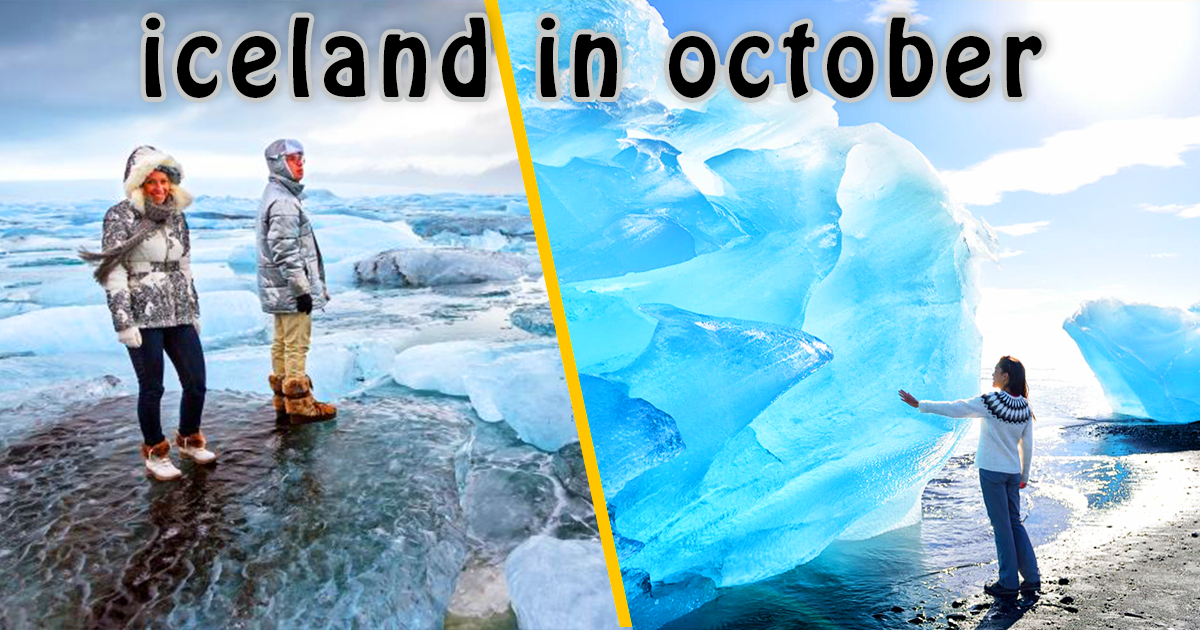What’s Iceland Like in October?
October in Iceland marks the beginning of the colder season, but it’s still a great time for exploration. The temperatures begin to drop, but the landscapes are vibrant with autumn colors, and there’s a magical feel to the crisp air.
Weather in Iceland in October
The average temperature in Iceland in October ranges between 1°C and 8°C (34°F to 46°F). You can expect occasional rain, wind, and even snowfall in the northern parts. Iceland’s weather in October can be unpredictable, so it’s important to be prepared for all conditions.
Daylight Hours in October
Daylight hours shorten as winter approaches. Early October offers around 11 hours of daylight, but by the end of the month, you can expect only about 8 hours. This reduction in daylight means you’ll need to plan your sightseeing carefully, but it also gives you more chances to see the Northern Lights!
Why Visit Iceland in October?
October is considered a shoulder season in Iceland, meaning fewer tourists and lower travel costs. This quieter period allows for a more peaceful experience while enjoying Iceland’s stunning natural beauty. Here are some compelling reasons to visit Iceland in October:
- Fewer Crowds: Popular spots like the Golden Circle, Blue Lagoon, and South Coast are less crowded, giving you a more intimate experience with nature.
- Affordable Travel: Flight and accommodation prices are generally lower in October compared to the busy summer months.
- Autumn Landscapes: The autumn colors add a striking contrast to Iceland’s rugged terrain, making for beautiful photo opportunities.
Top Things to Do in Iceland in October
Iceland offers a range of exciting activities in October, from exploring glaciers to witnessing the Northern Lights. Here are some must-do experiences:
1. Chase the Northern Lights
One of the biggest attractions in Iceland in October is the chance to see the Northern Lights (Aurora Borealis). With longer nights, you have a higher chance of spotting this natural phenomenon. For the best viewing experience, head to remote areas away from city lights, such as Þingvellir National Park or the Westfjords.
2. Explore Glaciers and Ice Caves
October marks the start of the ice cave season in Iceland. Guided tours to glacier caves, such as the Vatnajökull Glacier, offer a once-in-a-lifetime opportunity to explore the stunning ice formations that are only accessible in colder months.
3. Visit Waterfalls and Hot Springs
Iceland is famous for its waterfalls, and October is a great time to visit them. Gullfoss, Seljalandsfoss, and Skógafoss are all beautiful this time of year, with fewer tourists. Additionally, you can relax in natural hot springs like the Secret Lagoon or the Blue Lagoon after a day of exploring.
4. Whale Watching
October is still a good time for whale watching in Iceland. Tours from Reykjavík and Akureyri offer the chance to see minke whales, humpback whales, and dolphins.
Can You See the Northern Lights in Iceland in October?
Absolutely! October is one of the best months to witness the Northern Lights in Iceland. The longer nights provide the perfect backdrop for this magical display. To maximize your chances of seeing the aurora, follow these tips:
- Check the Forecast: Use apps like the Aurora Forecast to track Northern Lights activity.
- Find Dark Locations: The farther you are from light pollution, the better your chances. Locations like Vík and Kirkjufell are excellent for aurora hunting.
- Be Patient: The Northern Lights can appear and disappear suddenly, so patience is key.
Driving in Iceland in October: What You Need to Know
Driving in Iceland during October can be both rewarding and challenging. Here are some important things to keep in mind:
Road Conditions
The roads can be wet, icy, or even snowy in some areas during October. While major roads like Route 1 (the Ring Road) are generally well-maintained, some smaller roads, especially the F-roads in the highlands, may close for the season.
Renting a Car
If you plan to drive, renting a 4×4 vehicle is recommended in October. These cars handle Iceland’s unpredictable conditions better, especially if you plan to venture off the main roads.
Safety Tips
- Check Road Conditions Daily: Use the website road.is for real-time updates on road conditions.
- Drive with Caution: Icelandic roads can be slippery, so reduce your speed, especially in wet or icy conditions.
What to Pack for Iceland in October
Packing for Iceland in October requires a good balance of warmth and waterproof gear. Here’s a quick guide to what you’ll need:
- Waterproof Jacket and Pants: Rain and wind are common in Iceland, so waterproof outerwear is essential.
- Layered Clothing: The key to staying warm in Iceland is layering. Start with a thermal base layer, add a fleece or wool sweater, and finish with a waterproof jacket.
- Warm Accessories: Hats, gloves, and scarves are a must to protect against the cold.
- Sturdy Boots: Waterproof hiking boots are recommended for exploring Iceland’s rugged terrain.
- Camera and Tripod: If you’re hoping to capture the Northern Lights or the stunning autumn landscapes, don’t forget your camera gear.
Best Places to Visit in Iceland in October
Even though the weather can be cooler, October is still a fantastic time to visit some of Iceland’s most iconic destinations. Here are the top places to include in your itinerary:
- Golden Circle: Visit Þingvellir National Park, Geysir geothermal area, and Gullfoss waterfall. This popular route is less crowded in October.
- South Coast: Explore black sand beaches like Reynisfjara, the Seljalandsfoss waterfall, and the Jökulsárlón glacier lagoon.
- Westfjords: For a more off-the-beaten-path experience, the Westfjords offer stunning fjords, remote villages, and the chance to see Arctic foxes.
- Snæfellsnes Peninsula: Known as “Iceland in Miniature,” this region offers diverse landscapes, from mountains and lava fields to waterfalls and beaches.
October Festivals and Events in Iceland
While October is quieter in terms of tourism, it’s a lively time for local festivals. If you’re in Reykjavik, don’t miss the Reykjavík International Film Festival. This annual event showcases films from around the world and is a great way to experience Iceland’s culture.
Other events in October include local harvest festivals and cultural exhibitions in smaller towns and villages.
Experience the magic of the Northern Lights in Iceland by watching YouTube videos to see what awaits you in October!
What to Wear in Iceland in October: Essential Packing Tips
When visiting Iceland in October, the weather can be unpredictable, so it’s essential to pack smart. Layering is key to staying warm and comfortable throughout the day. Start with a moisture-wicking base layer to keep sweat away, followed by an insulating mid-layer such as a fleece jacket or wool sweater. Top it off with a waterproof and windproof outer layer to protect yourself from Iceland’s frequent rain and strong winds.
Sturdy, waterproof boots are a must for walking on uneven terrain and keeping your feet dry. Don’t forget accessories like a warm hat, gloves, and a scarf, as they will help you stay cozy, especially during nighttime Northern Lights hunting.
Icelandic Cuisine to Try in October
No trip to Iceland is complete without sampling some of the local cuisine. October is a fantastic time to indulge in traditional Icelandic dishes, often made with fresh, seasonal ingredients. Make sure to try Icelandic lamb soup (kjötsúpa), a hearty dish that’s perfect for warming up after a day of exploring. Seafood lovers will enjoy Iceland’s fresh fish dishes, such as Arctic char and cod.
For an authentic culinary experience, visit one of Reykjavik’s local restaurants or head to the countryside for farm-to-table meals. Many places also offer skyr, a thick, creamy yogurt that’s both delicious and nutritious.
By enjoying the local food, you’ll gain insight into Iceland’s culture and history while savoring the unique flavors of the island.
Is October a Good Time for a Road Trip in Iceland?
Yes, October is an excellent time for a road trip in Iceland if you’re well-prepared. The weather can be unpredictable, but the fall colors and quieter roads make for a memorable journey. A Ring Road road trip is still possible in October, and with fewer tourists, you’ll have more flexibility to explore at your own pace.
Suggested Itineraries:
- Golden Circle & South Coast: A 3-5 day trip that covers some of Iceland’s most iconic sites.
- Ring Road: For those with 7-10 days, a full Ring Road tour offers the chance to see all of Iceland’s natural wonders.
Conclusion: Should You Visit Iceland in October?
In summary, Iceland in October offers a unique experience for travelers seeking fewer crowds, stunning landscapes, and the opportunity to see the Northern Lights. With the right preparation and a sense of adventure, October can be one of the best times to visit this incredible destination.
FAQs About Iceland in October
1. Can you hike in Iceland in October?
Yes, many hiking trails are still accessible in October. However, it’s important to check weather conditions and be prepared for wet or snowy paths.
2. Is it expensive to visit Iceland in October?
October is more affordable than peak summer months, with lower prices on flights and accommodations.
3. Do I need a 4×4 vehicle for October travel?
A 4×4 is recommended, especially if you plan to explore areas with rough terrain or icy roads.
For more tips and travel inspiration, check out My Read Magazine.
Philip John is the dedicated admin of My Read Magazine, ensuring every article meets the highest standards before publication. With years of editorial experience, he carefully reviews each piece for accuracy, clarity, and relevance. His commitment to quality helps maintain the magazine’s reputation as a trusted and reliable source of information for readers worldwide.




